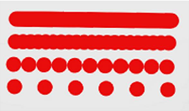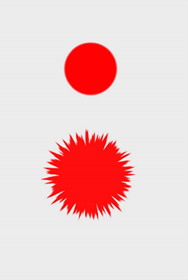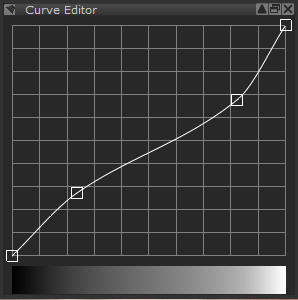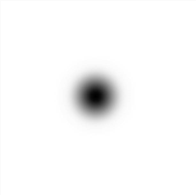Search is based on keyword.
Ex: "Procedures"
Do not search with natural language
Ex: "How do I write a new procedure?"
Brush Properties
For each brush, Mari specifies several properties that you can view and change.
To view the properties of a brush, select a painting tool such as Paint, Blur, Vector Paint, Paint Through, Gradient, and Clone Stamp, then select a brush in the Shelf palette, and open the Tool Properties palette. The following properties display.
|
Property |
Explanation |
Example |
|---|---|---|
|
Brush Settings |
||
|
Noise |
How much noise to add to each splat, to soften the appearance and reduce banding. Lower values give a harder brush, higher values a softer brush. (You can also add noise to the brush tip itself - under the Noise section below.) Range: 0.00 to 100.00, Reset: 0 |
|
|
Spacing |
The space between splats, as a proportion of the width of a splat. 1.00 = side-by-side (so if the tip is a circle, it would look like a string of beads.) .02 = .02 x the width of a splat. Range: 0.02 to 5.00, Reset: 0.02 |
A stroke from the same brush with spacing set to .02, .25, .50, and 1.0:
|
|
Paint |
||
|
Opacity |
How dark a stroke can be (maximum alpha). Range: 0.01 to 1.00, Reset: 1.00 |
A stroke from the same brush with opacity set to 1.00 and 0.50 with no jitter, and 1.00 with maximum jitter:
|
|
Flow |
Mimics how quickly paint is applied, by setting the maximum opacity in a splat. Range: 0.01 to 1.00, Reset: 1.00 |
A completely hard brush tip, full opacity, with spacing of 0.15 and flow at 1.00 and 0.30:
|
|
Jitter Opacity |
Whether to randomly vary the opacity (to the degree specified in Jitter Opacity Max). |
|
|
Jitter Opacity Max |
How much to randomly vary the opacity (if JitterOpacity is enabled). Range: 0.00 to 1.00, Reset: 0.00 |
|
|
Position |
||
|
Jitter Position |
Whether to randomly vary displacement from the line of the brush stroke (to the degree specified in Jitter Position Max). |
|
|
Jitter Position Max |
How many pixels at most to randomly vary displacement from the line of the brush stroke (if JitterPosition is enabled). Range: 0 to 1000, Reset: 20 |
|
|
Pressure Whether pressure on the graphics tablet affects properties of a splat (as calibrated for your tablet) |
||
|
Colors |
Whether more pressure increases the color strength. |
|
|
Radius |
Whether more pressure increases the radius. |
|
|
Flow |
Whether more pressure increases the flow. |
|
|
Opacity |
Whether more pressure increases the opacity. |
|
|
Radius |
||
|
Radius |
How many pixels at most the radius of splat can be (if JitterRadius and/or RadiusPressure are enabled). Range: 1 to 1200, Reset: 100 |
A stroke with and without radius jitter, where the jitter is equal to the whole radius of the brush:
|
|
Squish |
How much to flatten the radius. If the brush tip is a circle, 1.0 is a circle, .5 is an oval half as tall as it is wide. Range: 0.05 to 1.00, Reset: 1.00 |
|
|
Jitter Radius |
Whether to randomly vary the radius (to the degree specified for the Radius and InnerRadius). |
|
|
Inner Radius |
How few pixels the radius of a splat can be (if JitterRadius and/or Radius Pressure are enabled). Range: 1 to 1200, Reset: 1 |
|
|
Rotation |
||
|
Rotation |
The degree to which the brush rotates to match the direction you're painting (if Align to Stroke is enabled). Range: 0.00 to 360.00, Reset: 0.00 |
|
|
Align to Stroke |
Whether the brush tip rotates along with the direction you're painting. (With calligraphy, for example, the tip does not align.) |
|
|
Jitter Rotation |
Whether to randomly vary the rotation. |
|
|
Jitter Rotation Max |
How many degrees at most to randomly vary the rotation (if Jitter Rotation is enabled). Range: 1 to 360, Reset: 360 |
|
|
Steady Stroke |
||
|
Mode |
Whether to use the Off, Distance, or Smoothing mode. Reset: Distance |
|
|
Delay |
Defines how much delay is used for the brush stroke. In Distance mode, the Delay uses the specified amount of screen pixels, keeping a fixed distance, to define the brush stroke. In Smoothing mode, the Delay uses the moving average of the cursor movement to define the brush stroke. Note: When you move the mouse very fast, Mari gets fewer samples, so the delay looks longer. Range: 0 to 200. Reset: 0.00 |
|
|
Tail |
Whether to use the No Tail or Meet options for the finishing strokes. • Meet - The brush stroke catches up to the cursor's position when releasing the mouse or pen. • No Tail - The brush stroke stops as soon as the mouse or pen is released, with no catch-up. Reset: No Tail |
|
|
Tilt |
||
| Y Stretch | Stretches the brush splat vertically (Y direction) based on tablet pen tilt. | |
| X Stretch | Stretches the brush splat horizontally (X direction) based on tablet pen tilt. | |
| Brush Tip | ||
|
Bitmap |
||
|
Use Painting |
Click to use the painting in the paint buffer as a brush tip. Mari prompts you to save it either as an .exr or a .tif file (which file format is used depends on the support in your graphics card). Note: EXR files are 16-bit - most other bitmaps are 8-bit. |
|
|
Path |
Type the path or click the button to select an existing bitmap to use as the brush tip. |
|
|
Type |
To use an image as the brush tip, you need to set Type to Bitmap. |
|
|
Geometry |
||
|
Vertical Shear |
How much to distort the brush tip diagonally, top to bottom (as if pulling opposite corners up and down). Range: -1.00 to 1.00, Reset: 0.00 |
|
|
Horizontal Shear |
How much to distort the brush tip diagonally, right to left (as if pulling opposite corners right and left). Range: -1.00 to 1.00, Reset: 0.00 |
|
|
Vertical Scale |
How much to distort the brush tip vertically. Range: 0.00 to 2.00, Reset: to .50 |
|
|
Horizontal Scale |
How much to distort the brush tip horizontally. Range: 0.00 to 2.00, Reset: to .50 |
|
|
Noise |
||
|
Octaves |
Number of applications of noise. Range: 1 to 8, Reset: 4 |
The same brush with the default and maximum noise:
|
|
Frequency |
How many spikes per octave. Range: 0.00 to 100.00, reset to 1.00 |
|
|
Scale |
How big the spikes are, as a proportion of the radius (1.00 = twice as big as the radius). Range: 0.00 to 1.00, Reset: 0.00 |
|
|
Segments |
Lines making up the brush outline, to which noise is applied (4=square, 360=circle). Range: 4 to 360, Reset: 360 |
|
|
Profile |
||
|
Profile |
For rendered brushes (see Brush Properties above), alpha profile of the brush tip from center to edge - determines how “hard” or “soft” it is.
In the Curve Editor, to move values along a curve, you can drag any of the points on the curve in any direction, and see the effects in the preview bar below the curve. Click to add a new point, and right-click to invert, select presets, and export and import settings. To remove a point, click on it while holding Ctrl/Cmd. |
Hard and soft brush tip profiles:
|
|
Bit Depth |
Byte (8-bit), Half (16-bit), or Float (32-bit) It is generally a good idea to use a brush with the same bit depth as the texture you're painting, to avoid stepping. Note that if you use an 8-bit bitmap, it still paints in 8-bit even if you set the bit depth to Half. |
|
| Resolution | ||
| Height Pixels | Set the height resolution of the brush tip. | |
| Width Pixels | Set the width resolution of the brush tip. | |
|
Scratch pad - shows a squiggle painted with the selected brush. You can also paint directly in the scratch pad (the default squiggle disappears while you enter a stroke). |
||
Note: The texture properties vary from one painting tool to the other and some tools do not have texture properties. Only the tools containing texture properties are listed below.
|
Property |
Explanation |
Example |
|---|---|---|
|
Texture |
||
|
|
||
|
Blur |
Specifies the blur value. |
|
|
|
||
|
Description |
Displays the tool function. |
|
|
Name |
Displays the tool name. |
|
|
Image |
||
|
Filename |
Sets the filepath of the image file to project as a texture. |
|
|
Info |
||
|
Description |
Displays the colorspace information of the image used to project as a texture. |
|
|
Height |
Displays the image height. |
|
|
Width |
Displays the image width. |
|
|
Preview |
||
|
Preview Alpha |
Specifies the transparency of the image previewed over the canvas. |
Range: 0.10 to 1.00 |
|
Image |
Displays a preview of the image. |
|
|
Transform |
||
|
Image Scale |
Sets the scale of the image on the x and y axes. This scales the image relative to the image's size. |
|
|
Pan Lock |
Locks the image position relative to the model. If you pan the model, the image that you're painting through pans too. |
|
|
Scale Lock |
Locks the image size relative to the model. If you zoom the model in or out, the image that you're painting through zooms in or out too. |
|
|
Reset Size |
Resets to: • ToOriginalSize • RelativeToPaintBuffer |
|
|
Auto Reset |
Sets the Auto Reset option to: • Reset • DoNotReset |
|
|
Reset |
Resets any transformations applied to the image using the Image Scale, Rotation, Scale or Translation options. This Reset option is dependent on what you set in the Reset Size and Auto Reset options. |
|
|
Rotation |
Sets the rotation of the image used by the Paint Through tool. |
|
|
Scale |
Sets the scale of the image on the x and y axes. This scales the image relative to the canvas size. |
|
|
Translation |
Sets the translated xy position of the image used by the Paint Through tool. |
|
|
|
||
|
Type |
Selects between Linear or Radial gradient. |
|
|
Out Point |
Specifies how far through the gradient the final color reaches. |
0.00 to 1.00, higher values imply the end color is reached later. |
|
In Point |
Specifies how far through the gradient the start color lasts for (before it starts graduating into the end color). |
0.00 to 1.00, higher values imply the start color finishes later. |
|
End |
Sets the final color for the gradient (color that the gradient ends up as). |
|
|
Start |
Sets the first color for the gradient (color the gradient starts out as). |
|
|
Preview |
|
|
|
Preview Alpha |
Selects the alpha value displayed by the preview of the gradient floating over the main canvas. |
Range: 0.10 to 1.00 |
|
Image |
Displays a preview version of the gradient. |
|
|
Transform |
|
|
|
Pan Lock |
Locks the image position relative to the model. If you pan the model, the gradient that you're painting pans too. |
|
|
Scale Lock |
Locks the image size relative to the model. If you zoom the model in or out, the gradient that you're painting zooms in or out too. |
|
|
Reset Size |
Resets to: • ToOriginalSize • RelativeToPaintBuffer |
|
|
Auto Reset |
Sets the Auto Reset option to: • Reset • DoNotReset |
|
|
Reset |
Resets any transformations applied to the image using the Image Scale, Rotation, Scale or Translation options. This Reset option is dependent on what you set in the Reset Size and Auto Reset options. |
|
|
Rotation |
Sets the rotation of the image used by the Gradient tool's preview. |
|
|
Scale |
Sets the scale of the image used by the Gradient tool's preview. |
|
|
Translation |
Sets the translated xy position of the image used by the Gradient tool's preview. |
|
|
|
||
|
Description |
Displays the tool function. |
|
|
Name |
Displays the tool name. |
|
|
Image |
|
|
|
Relative |
When enabled, clones from an offset point relative to the source point. When disabled, clones from the source point position. |
|
|
Clone From |
Sets values (0 to 1) to clone from the image on the x and y axes. |
|
|
Filename |
Sets the filepath of the image file used for clone stamping. |
|
|
Info |
|
|
|
Description |
Displays the bit depth and the image channels of the image used for clone stamping. |
|
|
Height |
Displays the image height. |
|
|
Width |
Displays the image width. |
|
|
Preview |
|
|
|
Onscreen Preview |
When enabled, displays the image on the canvas. |
|
|
Preview Alpha |
Specifies the level of transparency of the image preview displayed over the canvas. |
Range: 0.100 to 1.000 |
|
Image |
Displays a preview of the image used for clone stamping. |
|
|
Transform |
|
|
|
Image Scale |
Sets the scale of the image on the x and y axes. This scales the image relative to the image's size. The button locks the current Image Scale values so that any changes to scale are applied proportionately to both axes. |
|
|
Pan Lock |
Locks the image position relative to the model. If you pan the model, the image that you're painting pans too. |
|
|
Scale Lock |
Locks the image size relative to the model. If you zoom the model in or out, the image that you're painting zooms in or out too. |
|
|
Reset Size |
Resets to: • ToOriginalSize • RelativeToPaintBuffer |
|
|
Auto Reset |
Sets the Auto Reset option to: • Reset • DoNotReset |
|
|
Reset |
Resets any transformations applied to the image using the Image Scale, Rotation, Scale or Translation options. This Reset option is dependent on what you set in the Reset Size and Auto Reset options. |
|
|
Rotation |
Sets the rotation of the image used by the Clone Stamp tool's preview. |
|
|
Scale |
Sets the scale of the image on the x and y axes. This scales the image relative to the canvas size. |
|
|
Translation |
Sets the translated xy position of the image used by the Clone Stamp tool's preview. |
|
|
Scratch pad - shows a squiggle painted with the selected brush. You can also paint directly in the scratch pad (the default squiggle disappears while you enter a stroke). |
||
Sorry you didn't find this helpful
Why wasn't this helpful? (check all that apply)
Thanks for your feedback.
If you can't find what you're looking for or you have a workflow question, please try Foundry Support.
If you have any thoughts on how we can improve our learning content, please email the Documentation team using the button below.
Thanks for taking time to give us feedback.







